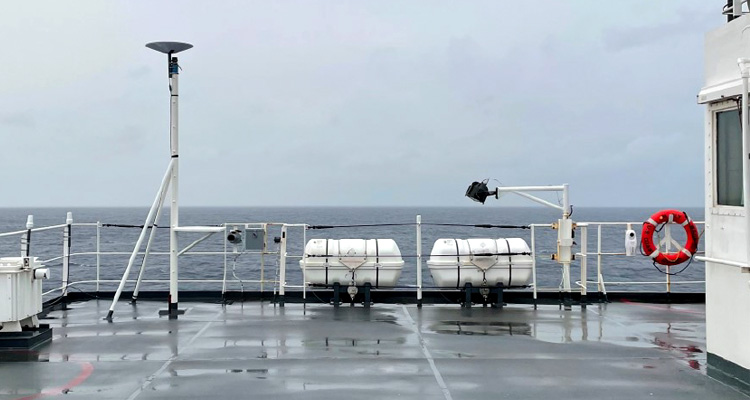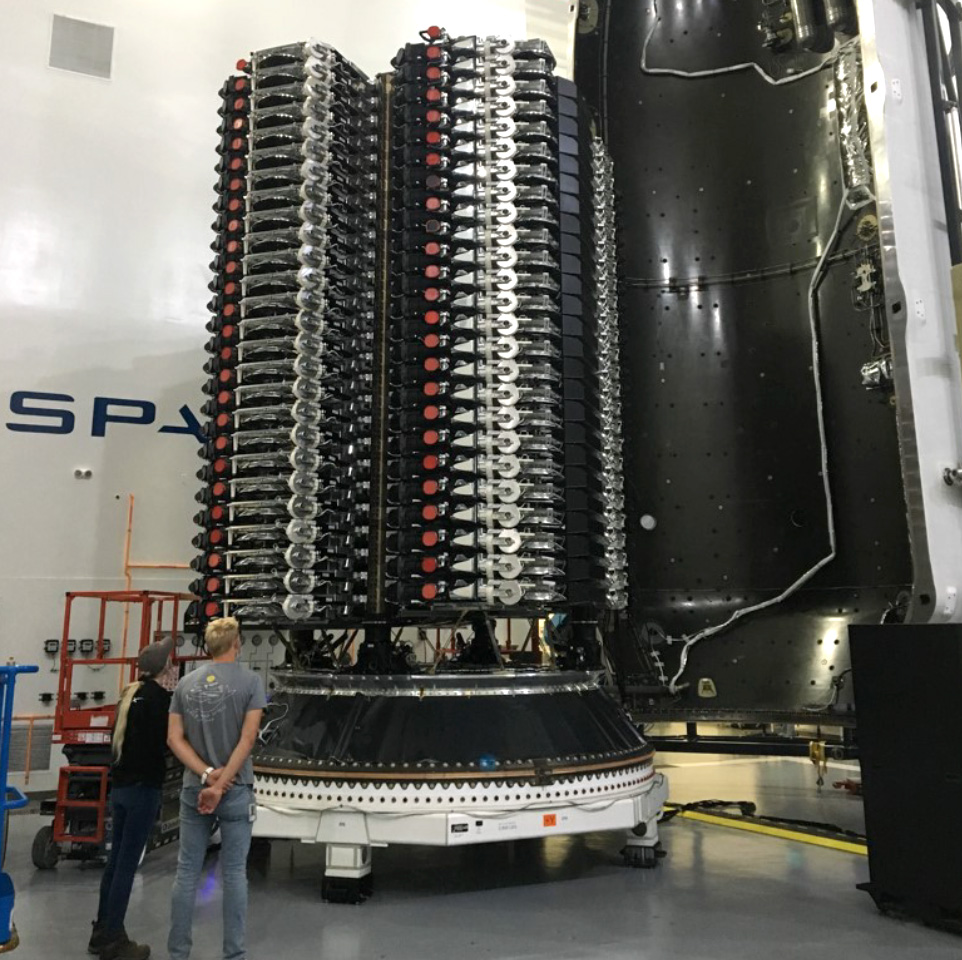Oct. 7, 2022 —

Starlink on Coast Guard Cutter Healy while underway in fall 2021. U.S. Coast Guard photo.
The Coast Guard Research, Development, Test & Evaluation (RDT&E) and Innovation Program is evaluating if new satellite constellations in low-earth orbit can provide network connectivity to cutters operating at high latitudes, where connectivity using geostationary satellites is currently lacking.
For underway network connectivity, Coast Guard cutters rely on services that utilize geostationary satellites orbiting 22,236 miles above the equator. These satellites are called geostationary because they appear to be in the same location in space relative to the earth since the speed at which they must orbit to overcome the pull of gravity is the same speed the earth is rotating.
For a ship underway in lower latitudes, the satellite terminal antenna needs to point at the same place in the sky to maintain a connection with the satellite. As the ship travels north or south from the equator, the satellite’s relative position in the sky begins to drop toward the horizon. At 74 degrees north or south the geostationary satellite is no longer visible because it is below the horizon and Coast Guard cutters operating at a higher latitude than 74 degrees consistently report loss of network connectivity, thus the need for this research.
Low-earth orbit satellites operate in altitudes between 400 and 2,000 kilometers above the earth’s surface and do not remain fixed in a synchronous orbit with a single point on the ground. Instead, these satellites orbit the earth at higher speeds and are not limited to the equatorial plane, which means that whole-earth coverage is possible. Low-earth orbit satellites in a polar orbit, for example, enable terminal antennas located at latitudes above 74 degrees to connect and are used for communications, science, military reconnaissance and other applications.
The Research and Development Center (RDC) is executing the High Latitude Underway Connectivity project to see if low-earth orbit satellite constellations such as Iridium, Starlink or OneWeb are able to provide network connectivity for Coast Guard cutters when the geostationary satellites drop below the horizon. This research is a collaboration with the Air Force Research Lab’s Global Lightning Project, which has a contract with SpaceX and OneWeb. Other partners include the Department of Homeland Security Science and Technology Directorate Office of University Programs, the Navy Stratospheric Community of Interest and the Coast Guard Command, Control, Communications, Computers, Cyber and Intelligence Service Center Deployed Connectivity Section.

Starlink satellites. Photo courtesy of SpaceX.
Starlink connectivity was tested during Coast Guard Cutter Healy’s deployment in fall 2021 as part of RDT&E’s annual Polar Regions Technology Evaluation. The Air Force Research Lab Global Lightning project provided a prototype Starlink terminal, satellite airtime and access to SpaceX engineers for this at-sea testing. Using a prototype beam stabilization software that compensates for the forward motion, yaw, pitch and roll of the ship by electronically steering the antenna to track the satellites while the vessel is in motion, Healy was able to maintain an internet connection with downlink speeds similar to a broadband connection. The focus of the testing was data collection for follow-up evaluation.
During the testing, Starlink was connected to the morale Wi-Fi on board, enabling the Healy crew to connect with people back home through emails and video calls and to utilize streaming services for entertainment. In another test, the network supported a Microsoft Teams video meeting between the Healy crew, operating off the coast of Florida during the cutter’s circumnavigation of North America, and the Starlink team in Seattle, Washington.
Holly Wendelin, C5ISR domain lead with RDT&E, and Jon Turban, research lead for this project at the RDC, provided more details.
Question: Why is this research important? What is the Coast Guard getting out of this project?
Wendelin: In order to operate effectively, maintain maritime domain awareness and share information across the maritime community, the Coast Guard must maintain resilient communications in the Arctic through innovation. Emerging satellite constellations and other communications technology offer new and effective ways to augment cutter and aircraft communications capabilities in the high latitudes.
Question: What significant findings were observed with Starlink while it was in use on Healy in 2021?
Turban: Significant findings observed with Starlink while it was in use at sea testing on Healy were that the satellite terminal was able to maintain a network connection while Healy was underway, resulting in a successful evaluation.
Question: Just to clarify, internet connectivity for Healy at sea via Starlink last time meant that crewmembers could text, search via web browser, download and connect to the CG network, same as if they were on land?
Turban: Almost correct. It worked as well as a network at home or at work; crewmembers could also stream videos, do video Teams calls, online gaming, watch Netflix, etc., anything you can use the internet for. We did not connect to the Coast Guard network but there is the ability to do so at a later time with proper security measures and approvals.
Question: Do Coast Guard ships have internet connectivity all the time when they are not in high latitudes?
Turban: Coast Guard ships do not have internet connectivity while underway. When not in high latitudes, ships have connectivity to the Coast Guard Network via geostationary satellites.
Question: What are the next steps for the project?
Wendelin: Limited user evaluations of both Naval Information Warfare Center’s OneWeb and Starlink are continuing through summer/fall 2022. A OneWeb terminal was installed at Coast Guard Base Kodiak and a Mobile Starlink terminal was installed on board Healy for 2022 deployment. An interim report will be delivered in March 2023 and all project-limited user evaluations will be complete in March 2024.
Turban: The Starlink testing is continuing while the Healy is underway this fall and on the Coast Guard Cutter Polar Star when it travels to Antarctica this winter.
Question: What is different about the testing being done this year? What are the objectives for this second phase?
Turban: The Starlink system is still being built by SpaceX and is not 100 percent operational. This year we will test more of Starlink’s capabilities as they are implemented.
Question: Could Starlink or a similar satellite potentially solve the issue of communication challenges in the Arctic? Are these low earth orbit satellites the future of communications in the Arctic, or do you foresee a shift to something else?
Wendelin: I don’t think that any one of these emerging satellite technologies could single-handedly solve the communications challenges in the Arctic, but each one could provide layers of communication resiliency that will contribute to robust high latitude communications and mission performance.
Question: Do you anticipate a variation in service based on the different geographic locations of each pole?
Turban: No, there is not an anticipation a variation in service based on the different geographic locations of each pole.
Question: Connectivity has been seen to be dependent on speed as a variable, how is that affected when traveling through Arctic climates (pack ice, etc.)? What about weather changes, such as severe storms, etc.?
Turban: Regarding weather changes, such as severe storms, etc., we do not anticipate a variation in service but have not verified this. Testing last year on Healy occurred off the East and West Coasts of the continental United States. Arctic testing is planned for fiscal years 2023-2023.
Question: How long are these satellites in orbit? Sustainable? How long does the service last?
Turban: While we don’t currently know how long these satellites remain in orbit, or how long the service lasts in terms of sustainability, we would anticipate that SpaceX would replace satellites when needed.
Question: What types of security measures are employed to ensure secure transmission of data via the low earth orbit and Starlink systems?
Wendelin: The Starlink connection is encrypted, but even so, it is not connected to the Coast Guard network on board Healy. Instead, it is connected to the science network available on board, which is a separate network administered by the Coast Guard and is public/unclassified. We are also using test beds that simulate a cutter at high latitudes that are in no way connected to a Coast Guard network.
Question: What does a public/private collaboration of this scale entail? How are you able to find the right partners to work with on this effort?
Wendelin: The public portion consists of our partnerships with the U.S. Department of Homeland Security Science and Technology Directorate Office of University Programs, U.S. Navy Stratospheric Community of Interest, Navy Information Warfare Center and the Air Force Research Lab. The private part consists of our work with corporate entities such as SpaceX, Amazon and Iridium. The first task of this project was to complete a High Latitude Satellite Systems Market Research effort. This was completed and a report delivered in March 2021. This survey enabled us to identify the most promising emerging technologies on the market and establish relationships with those entities directly or via the other government partners mentioned above.
Question: How scalable is the fielded prototype product? Will it be just for polar security cutters or could there be potential for other vessels to utilize as well depending on scope?
Turban: This service can be used on other Coast Guard cutters, not just icebreakers and polar security cutters.
Question: If successful, is this expected to be implemented/transitioned?
Wendelin: The final report from this project will provide the Office of Command, Control, Communications, Computers, Cyber and Intelligence (C5I) Capabilities with the market research results, and the results of the testing within the high latitude cutter test bed and limited user evaluations. The Office of C5I Capabilities may then use this information to acquire and provide enhanced underway connectivity technology and services for cutters.
For more information: Research, Development, Test & Evaluation Program page and Research and Development Center page